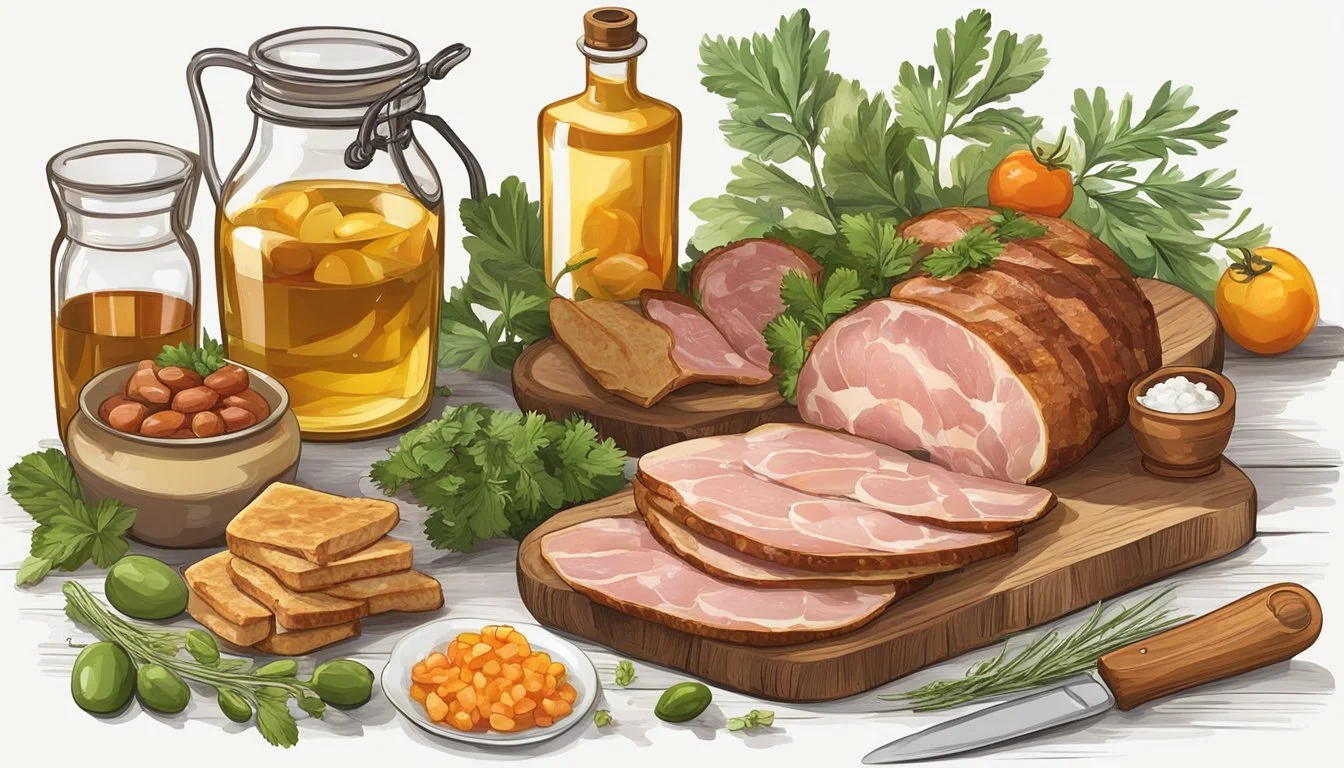Salo Ukraine's Culinary Passion for Tradition and Flavor
Salo is a traditional Ukrainian delicacy that epitomizes the nation's long-standing culinary heritage. Often regarded as a national dish, salo holds a cherished place in Ukraine's gastronomy and cultural identity. It is essentially cured strips of pork fat, sometimes likened to unrendered lard, that have been treasured by Ukrainians for its rich flavor and cultural significance dating back to prehistoric times when early inhabitants domesticated pigs.
This beloved food item typically consists of the firm, white fat found on the back or sides of a pig, cured with salt, garlic, black pepper, and other spices, then aged to perfection. Salo can be savored raw, smoked, fried, or added to various dishes to enrich their flavor. Its versatility and distinctive taste profile make it a staple in Ukrainian households, celebrated for its ability to be both a simple peasant food and a gourmet delicacy.
While salo's closest relatives in the culinary world might be Italy's lardo di Colonnata or lard d'Arnad, Ukraine's passion for this cured pork fat is unmatched. It is not uncommon to see salo featured in festive feasts and everyday meals alike, indicating the deep love affair Ukrainians have with this savory treat.
Historical Significance of Salo in Ukraine
Salo, the cured pork fat, is deeply entwined with Ukrainian culture, forming a part of the traditional cuisine and reflecting the nation's sense of humor and resilience.
Culinary Traditions and Cultural Heritage
Salo has been a staple of Ukrainian cuisine for many generations, reflecting the agricultural past and the resourcefulness of peasant food preservation methods. The curing process transforms pork fat into a durable food item that could sustain families through harsh winters. It has evolved to embody the Ukrainian spirit, with its preparation and consumption becoming a means of cultural expression and continuity. Recognized as more than a mere dish, salo has come to symbolize Ukrainian identity and the nation's rootedness in its traditions.
Preparation: Salo is traditionally cured with salt, sometimes with the addition of garlic or black pepper for enhanced flavor.
Consumption: Often consumed with bread or as part of more complex dishes, it has been a constant presence at Ukrainian tables.
National Symbol: Its importance is such that it is seen as a national symbol, with festivals dedicated to it, highlighting its role in Ukrainian society.
Salo in Ukrainian Folklore and Humor
Salo's presence extends beyond the dinner table; it has a significant role in Ukrainian folklore and humor. Jokes regarding salo often reveal societal attitudes and are a testament to the food's deep social meaning. These jokes, typically lighthearted, showcase a community's self-awareness and the ability to find humor in its habits and history.
Folklore: Stories and proverbs featuring salo are common, reflecting its importance in daily life and its status as a symbol of hospitality and abundance.
Humor: Jokes surrounding salo serve as a playful reminder of its ubiquity in Ukrainian life, often highlighting a national affection for the food.
By understanding salo's place in the culinary traditions and humor of Ukraine, one gains insight into the ways food can weave into the fabric of a culture's history and identity, becoming an emblem of a nation's character and resilience.
Salo Production and Varieties
Salo, a traditional Ukrainian delicacy, is crafted from the dense fat located on the back of a pig. Renowned for its rich flavor, salo can be produced using time-honored methods or modern industrial techniques, each yielding various taste nuances.
Traditional Methods and Industrialization
Producers create salo through a curing process that begins with the careful selection of high-quality pig fat. Small-scale producers adhere to traditional methods where the fat is hand-cut, seasoned with salt, garlic, and spices, then left to cure. Some variations are smoked for additional complexity in taste, a practice particularly common in the Carpathian Mountains. These artisanal practices contribute to the Slow Food movement, emphasizing quality and traditional craftsmanship.
Modern industrialization of food production has influenced salo making as well. Larger facilities employ refrigeration and automated procedures to mass-produce salo. Still, many enthusiasts argue that these industrial methods lack the depth of flavor found in traditionally cured salo.
Regional Differences and Specialty Types
Distinct regional differences define the specialty types of salo across Ukraine and beyond.
The Carpathian region is esteemed for its smoked salo, often infused with the aroma of various woods.
In contrast, the Lardo di Colonnata from Italy, akin to Ukrainian salo, is cured in marble containers, imparting a unique flavour.
A table to illustrate some renowned salo types:
Carpathian Mountains, Ukraine: Salo Variety - Smoked Salo, Distinctive Feature - Smoked using traditional woods.
Central Ukraine: Salo Variety - Salted Salo, Distinctive Feature - Purely cured with salt and sometimes garlic.
Italy: Salo Variety - Lardo di Colonnata, Distinctive Feature - Cured in marble basins with a blend of spices.
Moreover, salo's regional disparities contribute to its identity, with some areas favoring spicy additions or distinct curing times, all of which add to the diversity of this Ukrainian staple in flavor and texture.
Health Aspects of Consuming Salo
Salo, a staple in Ukrainian cuisine made from cured pork fat, has a complex nutritional profile that challenges common perceptions about fat's role in diet. The health aspects of consuming salo can be assessed through its nutritional value and its place in modern dietary patterns.
Nutritional Value and Misconceptions
Salo is a significant source of energy and vitamins, such as vitamin A, D, and E, as well as minerals like selenium and zinc. Contrary to popular belief, pork fat can be a part of a healthy diet if consumed in moderation. Salo contains monounsaturated and saturated fats. Monounsaturated fats are known to be heart-healthy when they replace saturated fats in the diet. It is essential to acknowledge that while salo has some nutritional benefits, overconsumption could lead to increased risks for cardiovascular disease, particularly due to the high content of saturated fats which can contribute to artery blockages if consumed excessively.
Monounsaturated Fats: High
Saturated Fats: High
Vitamins A, D, E: Present
Minerals: Selenium, Zinc
Salo in Modern Diets
The incorporation of salo into modern diets depends on balancing flavor and moderation to maintain a healthy lifestyle. Its use in small quantities can leverage the flavor profile while limiting the health risks associated with high-fat foods. Health-conscious consumers may opt to integrate salo into a varied diet that also includes fiber-rich vegetables and fruits to support overall liver health and balance fat intake. Salo’s place in Ukrainian cuisine highlights the cultural significance of the food while underscoring the need for a conscientious approach to its consumption concerning health.
Salo in the Ukrainian Cuisine
Salo, the cured pork fat, is a staple in Ukrainian cuisine, treasured for its flavor and versatility. It appears in various traditional dishes and is commonly paired with staples like garlic, onion, and rye bread.
Familiar Dishes and Innovative Uses
Salo is often consumed raw, thinly sliced, or spread on bread. However, its culinary applications are diverse, including being rendered for cooking or incorporated into dumplings for a richer flavor. The innovative uses of salo extend to contemporary kitchens where chefs may incorporate it into dishes to add depth and a touch of Ukrainian identity. Traditional celebrations may boast a world's largest salo sandwich, showcasing salo's place in cultural festivities.
Pairing Salo with Other Foods and Spirits
A classic Ukrainian pairing involves salo with rye bread, accented by sharp flavors such as garlic or pickles. These combinations balance the richness of salo with acidity and spice, enhancing the overall tasting experience. Additionally, salo is often savored with spirits like vodka, which cuts through the fat's heaviness. The famous Ukrainian soup, borscht, may also be accompanied by salo, enriching the soup's hearty and robust nature.
Cultural Practices and Social Aspects
Salo has woven itself into the fabric of Ukrainian culture not only as a culinary staple but also as an emblem of heritage and resistance. The social landscape of Ukraine celebrates this unique product through festivals and symbolism that underscore its broader national significance.
Festivals Celebrating Salo
Salo Festivals in Ukraine are exuberant occasions that express the nation's affection for this delicacy. These festivals frequently feature a variety of events centered around salo, including:
Culinary Competitions: Chefs and amateurs alike showcase their skills in preparing salo-based dishes.
Record-Breaking Attempts: Efforts such as creating the world’s longest salo sandwich, which have entered the Ukrainian Book of Records, highlight the playful side of these celebrations.
Cultural Performances: Traditional music and dance accompany the feasting, echoing Ukraine’s rich history.
Salo as a Symbol of Ukrainian Resistance
Amidst historical tensions, particularly between Ukraine and Russia, salo has emerged as a symbol of Ukrainian identity and resistance. Its significance is reinforced in times of political challenge, serving as a quiet yet potent political position. Salo's presence in Ukrainian kitchens and festivals acts as a reminder of national unity, reflecting its:
Social Meaning: Beyond nourishment, salo is a representation of Ukrainian resilience and fortitude in the face of external pressures.
Everyday Significance: It holds a place in daily life, reinforcing Ukrainian identity through its continued use and consumption.
Salo Beyond the Culinary World
Salo has transcended its role as a revered Ukrainian delicacy by permeating the art world, with exhibitions dedicated to this cultural icon and its adaptation as an innovative material by contemporary artists.
Artistic Expressions and Exhibitions
Salo has inspired artistic expressions and has been the centerpiece of exhibitions that reflect its significance in Ukrainian culture. The Museum of Salo, for instance, is a unique institution that celebrates salo through art and culinary displays. Visitors can marvel at various artistic renditions of salo, showcasing how this food item has become more than a mere kitchen staple. This museum and similar art galleries organize events that bring the cultural importance of salo to a wider audience.
Salo as a Medium in Contemporary Art
As an innovative material, salo has caught the attention of contemporary artists, drawn to its provocative concept and versatility. These artists utilize salo as a medium to create thought-provoking pieces that challenge viewers’ perceptions and spark discussions beyond gastronomy. Their works often reflect on themes of tradition, consumption, and identity—inviting audiences to see salo in a new light. This unexpected use in art underscores salo's role in both fostering creativity and highlighting its deep roots in the identity of a nation.
Global Influence and Comparisons
Salo's cultural identity extends beyond Ukraine, with its presence felt in both international culinary scenes and comparisons with similar products worldwide.
Salo and Its Counterparts Abroad
In Italy, Lardo di Colonnata is a product that shares similarities with Ukrainian salo. Both are cured pork fat, but the Italian version is often seasoned with rosemary and other aromatic herbs and aged in marble vats. This method gives Lardo di Colonnata a distinct flavor profile. In the UK, there is growing interest in artisanal and organic food movements, and products like salo have found their place in the market, particularly in cities with a penchant for unique gourmet experiences, such as London.
The International Perspective on Ukrainian Salo
Internationally, Ukrainian salo is appreciated for its rich taste and cultural significance. It can be a symbol of national identity and belonging for Ukrainians abroad. The global organic movements also laud salo when produced with traditional methods, viewing it as a return to natural and unprocessed foods. In London, with its diverse culinary scene, salo can be found in Eastern European delis and markets, offering a taste of Ukraine to a broad audience.
Contemporary Issues and the Future of Salo
Contemporary trends and geopolitical shifts pose significant challenges and opportunities for Salo, Ukraine's cherished culinary staple.
Salo's Place in a Globalizing Market
In the face of globalization, Salo faces an evolving marketplace. Ukrainian producers grapple with both new demands and increased competition. Specifically, the European Union presents a double-edged sword; on one side, there's the allure of an expansive market ripe for Ukraine's food heritage, while on the other, stringent food regulations pose a significant hurdle. This situation highlights a tension between maintaining traditional food practices and satisfying international standards.
Exports: There's a growing interest in exotic and region-specific foods in the EU, which could increase demand for authentic Ukrainian Salo.
Standards: EU regulations may require Ukrainian producers to adapt their curing methods, which could affect the authenticity of Salo.
Preservation of Traditions versus Modernization
Salo is deeply rooted in Ukrainian culture, signifying more than just sustenance; it embodies national identity and pride. In preserving this culinary tradition, Ukrainians navigate between the reverence for a lost past and the pressures of modernization. Fieldwork—the practical study of Salo in its natural context—highlights the importance of traditional methods in crafting Salo's unique flavor and cultural significance.
Cultural Identity: As a centerpiece of Ukrainian identity, Salo's conservation is seen as resistance to cultural erosion amidst modern global influences.
Innovation: Artisans and chefs in Ukraine are experimenting with Salo to appeal to contemporary palates, integrating it into modern dishes while retaining its essence.
Salo's future will be shaped by Ukraine's ability to balance the preservation of its food heritage with the dynamics of an increasingly interconnected global market. This will involve navigating tensions with neighboring countries, especially Russia, and leveraging the uniqueness of Salo to cement its place not only in Ukrainian hearts but also on the world stage.








